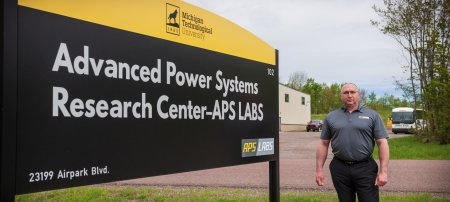Research with impact. That’s the Michigan Tech Research Award. This year’s award winner is a civil engineer with interdisciplinary chops.
Old tires make new roads. Zhanping You, professor of transportation engineering, wants to take one kind of transportation waste and let it pave the way to better infrastructure. Roads made from recycled tires is one example of the many pavement materials You develops, designs and deploys. By using both computer modeling and field road experiments, he specializes in where the rubber meets the road.
You does more than patch potholes — he develops transportation materials that minimize spalling, cracking and other damage in the first place — and he understands that a highway is not built in a day or by a single person. He is well recognized as a great mentor for undergraduate and graduate students and has hosted 30 international scholars in his lab. You has led national and international research conferences for various organizations, as well as well-known research projects. He balances the local and global nature of his field: Locally sourced materials provide the raw materials for a project, and climate is the greatest challenge in improving and customizing transportation materials; but it’s the specifications, implementation, collaboration and data analysis that connect an experimental Kalamazoo, Michigan road to highway test tracks in Minnesota.
"You’s funding record underscores the impact of his work in civil engineering materials and his publication record further demonstrates his ability to communicate to a wide-range of audiences, to advance the use of asphalt and bituminous materials in civil engineering applications."
Q: What’s your research about?
A: I study transportation materials. That means pavement, asphalt and concrete roadways — and their sustainable alternatives. We do a lot of tests to make sure a material is going to perform well. We examine the mechanical and chemical properties through computer modeling, lab experiments and real-world assessment in the Department of Civil and Environmental Engineering.
For example, last summer I worked with the Road Commission of Kalamazoo County to install 6 lane miles of road made of recycled tires. We’ll be heading back down there to see how the material did through the winter. Before the asphalt-tire-gravel mix ever made it outside, we did plenty of work indoors, using computer modeling and lab tests to make sure we put viable material out in the elements. We’ll be installing a similar road in Iron Mountain here in the Upper Peninsula, and I have studied around the world on best practices for testing pavement in China, France, Spain, Switzerland and Canada. I also have a new collaboration with Minnesota’s MnROAD test track where we’ll be running a fully loaded truck and another 3.5-mile stretch of highway with real traffic on interstate highway.
Q: All of us drive on roads; we take them for granted. What do you want us to know about transportation materials?
A: The public pays for many roads, so they deserve and need to know about how we are working to improve them. The cost for infrastructure projects that the public sees vary from year to year. Cost goes up and down depending on resources, climate makes a huge difference from state to state, and transportation materials have to account for limitations in both climate and construction.
I focus a lot on the sustainability of construction. We deal with all kinds of recycled materials: recycled pavements — using old blacktop and underlayers to make new roads, recycled roof shingles, and recycled tires. Of course we also studied recycled plastics, recycled engine oil, and bio asphalt derived from biomass.
"Zhanping You is greatly deserving of Michigan Tech’s highest honor for research. Thanks to his multidisciplinary approach, our roads will last longer and endure even more extreme weather with increased sustainability and cost-effectiveness."
Q: How have your methods helped make your projects successful?
A: In the lab we’re testing for the right ingredients. We want to know how much asphalt, how much gravel, how much sand — we get the recipe ready. And we try to use local materials, because if the project is going to be in Iron Mountain, then contractors will get all the sand, gravel and everything from there when possible. So as we get ready for each roadway test site, we have to ensure that our recipes match up with what’s available.
Once we’re working on the road itself, we’re looking for issues with low temperature cracking due to cold weather, rutting from heavy loads, moisture damage potential and material fatigue. Road function makes a difference, too: An expressway is going to need different materials than a low-volume residential street in town.
Also, computer modeling helps us understand the fundamental mechanisms that govern material behavior and performance. We don’t want to walk into the lab in the dark and blindly test materials — models turn on the light. When I started my research as a PhD student, we focused on 2D discrete element and finite element models; now we can do it in 3D with complex gravel shapes. Specifically, we use discrete element methods that enable us to examine the movement of particles and their mechanical response to temperature and traffic over time.
The actual math is complex, but models can be applied to construction projects around the world and modeling is a crucial research skill. More than 90 percent of my papers include undergraduate and graduate authors; they can be a part of these research endeavors because I am making sure they get the coding experience and software skills they need to be successful professionals and researchers. Students in my research group are not simply lab technicians.
"It is unusual to find such a highly accomplished scholar who is well regarded as a student and research mentor."
Q: What are the challenges you face in your research?
A: Climate. Up here we have ice and snow. Down south it’s hot. Climate is the most challenging aspect of developing transportation materials and there is no one-size-fits-all approach. That’s why it’s important to collaborate with state transportation agencies to help them customize materials for their location with the resources at hand.
At the same time, there is global demand for exchanging information, often across scientific disciplines. Getting the right people to the right conversation is as challenging — and as rewarding — as dealing with freeze-thaw cycles and 100-plus degree days on the roads. Building up teams is what transportation engineering needs, which is why I see myself as a teacher as well as a researcher. My teaching practice and my industry networks help to fuel my research.
"Zhanping You is a world-renowned researcher in the field of bituminous materials, pavement design and sustainable engineering. Scholars from around the world seek opportunities to work with him."
Michigan Technological University is an R1 public research university founded in 1885 in Houghton, and is home to nearly 7,500 students from more than 60 countries around the world. Consistently ranked among the best universities in the country for return on investment, Michigan's flagship technological university offers more than 120 undergraduate and graduate degree programs in science and technology, engineering, computing, forestry, business, health professions, humanities, mathematics, social sciences, and the arts. The rural campus is situated just miles from Lake Superior in Michigan's Upper Peninsula, offering year-round opportunities for outdoor adventure.







Comments